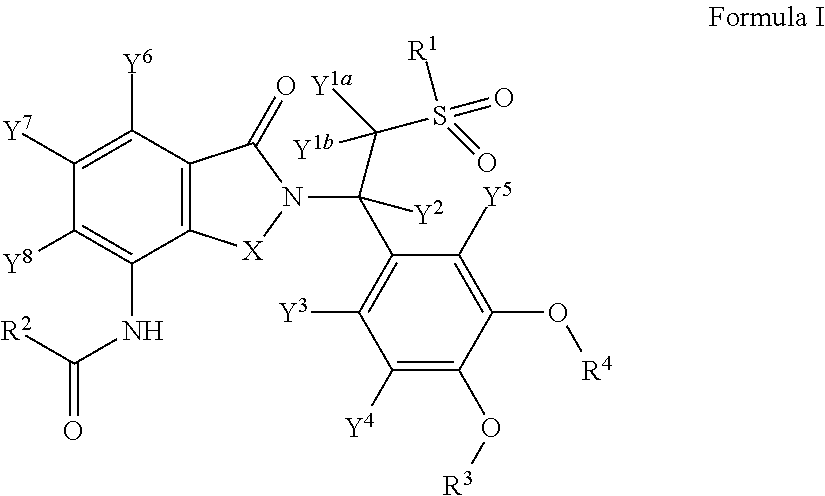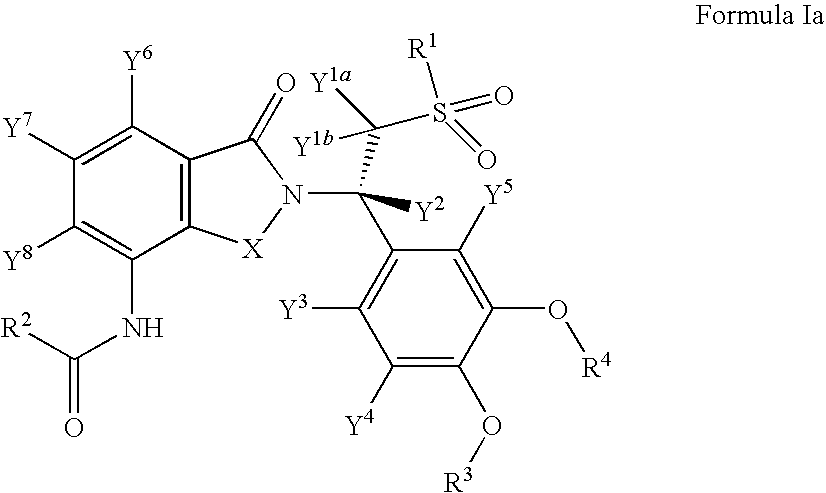Substituted isoindoline-1,3-dione derivatives
a technology of substituted isoindoline and derivatives, which is applied in the field of substituted isoindoline1, 3dione derivatives, can solve the problems of poor absorption, distribution, metabolism and/or excretion (adme) properties, and the poor adme properties of many current medicines
- Summary
- Abstract
- Description
- Claims
- Application Information
AI Technical Summary
Benefits of technology
Problems solved by technology
Method used
Image
Examples
example 1
Synthesis of (S)-N-(2-(1-d-2-(Methylsulfonyl)-1-(3-(ethoxy-d5)-4-(methoxy-d3)phenyl)ethyl)-1,3-dioxoisoindolin-4-yl)acetamide (Compound 113a)
[0136]
[0137]Step 1. Ethyl 3-hydroxy-4-(methoxy-d3)-benzoate (23). Commercially available ester 22 (10 g, 55 mmol) was mixed with CD3I (99 atom % D, Cambridge Isotopes; 8.1 g, 55 mol) and K2CO3 (7.59 g) in DMF and stirred at room temperature over a weekend. LCMS showed three peaks with masses consistent with starting material (20%), the desired monoalkylated 23 (55%) product and the bisalkylated (23%) by-product. The reaction was filtered through a pad of Celite, washing with EtOAc, and the filtrate concentrated to almost dryness. The residue was dissolved in CH2Cl2 (300 mL) and the solution was washed with water (5×50 mL), brine, dried (Na2SO4) and concentrated. The crude product was purified by chromatography on silica gel eluting with EtOAc / heptane (1:9 to 1:6) then further triturated from heptane to give 4.1 g (36%) of the desired 23.
[0138]S...
example 2
Synthesis of (S)-N-(2-(2-(Methylsulfonyl)-1-(3-(ethoxy-d5)-4-(methoxy-d3)phenyl)ethyl)-1,3-dioxoisoindolin-4-yl)acetamide (Compound 107a)
[0144]
[0145]Step 1. 3-Hydroxy-4-(methoxy-d3)-benzaldehyde (27). Commercially available 3,4-dihydroxy-benzaldehyde 26 (10 g, 80 mmol) was dissolved in DMF (50 mL). K2CO3 (10 g) was added and the solution was cooled in an ice-water bath. CD3I (99 atom % D, Cambridge Isotopes; 12.4 g, 84 mmol) was slowly added. then the reaction was stirred at room temperature overnight. The reaction was diluted with EtOAc (200 mL) and filtered through a pad of Celite. The filtrate was concentrated to give a dark oil. EtOAc (150 mL) and water (50 mL) were added and the layers were separated. The aqueous phase was adjusted to pH 6 by the slow addition of 1N HCl and the mixture was extracted with EtOAc (2×100 mL). The combined organic solution was dried (Na2SO4) and concentrated. The crude material was purified by column chromatography on silica gel eluting with EtOAc / h...
example 3
Synthesis of (S)-N-(2-(2-(Methylsulfonyl)-1-(3-ethoxy-4-(methoxy-d3)phenyl)ethyl)-1,3-dioxoisoindolin-4-yl)acetamide (Compound 114a)
[0150]
[0151]Step 1. 3-Ethoxy-4-(methoxy-d3)-benzaldehyde (10c). A mixture of commercially available 16a (5 g, 30 mmol) and Cs2CO3 (15 g, 46 mmol) in acetone was cooled in an ice-water bath. (CD3)2SO4 (99 atom % D, Cambridge Isotopes; 2.7 mL, 30 mmol) was added and the reaction was allowed to warm slowly to room temperature and was stirred overnight. The mixture was filtered through a pad of Celite and concentrated to give 5.7 g (approx 100%) of 10c.
[0152]Step 2. 1-(3-Ethoxy-4-(methoxy-d3)-phenyl)-2-(methylsulfonyl)ethanamine (11c). Methyl sulfone (3 g, 32.1 mmol) was suspended in THF (280 mL) and cooled in an acetone / dry ice bath to below −70° C. n-BuLi (2.5 M in hexanes, 13.6 mL, 35.7 mmol) was added and the mixture was stirred about 30 minutes. In a separate flask a solution of 10c (5.7 g, 30.2 mmol) in THF (60 mL) was cooled to 0° C. LHMDS (1M in THF...
PUM
| Property | Measurement | Unit |
|---|---|---|
| temperature | aaaaa | aaaaa |
| pH | aaaaa | aaaaa |
| retention time | aaaaa | aaaaa |
Abstract
Description
Claims
Application Information
 Login to View More
Login to View More - R&D
- Intellectual Property
- Life Sciences
- Materials
- Tech Scout
- Unparalleled Data Quality
- Higher Quality Content
- 60% Fewer Hallucinations
Browse by: Latest US Patents, China's latest patents, Technical Efficacy Thesaurus, Application Domain, Technology Topic, Popular Technical Reports.
© 2025 PatSnap. All rights reserved.Legal|Privacy policy|Modern Slavery Act Transparency Statement|Sitemap|About US| Contact US: help@patsnap.com



